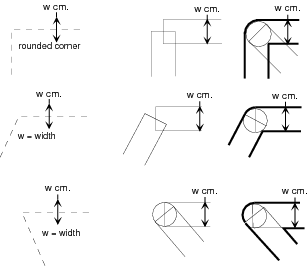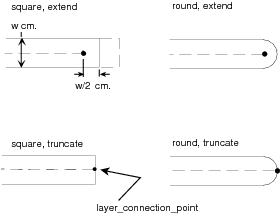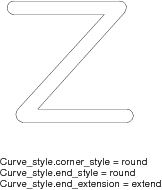|
|
Application module:
Constructive solid geometry 2D |
ISO/TS 10303-1731:2019(E)
© ISO
|
This clause specifies the information requirements for the
Constructive solid geometry 2D
application module. The information requirements are specified as the
Application Reference Model (ARM) of this application module.
NOTE 1 A graphical representation of the information
requirements is given in
Annex C.
NOTE 2 The mapping specification is specified in
5.1. It shows how
the information requirements are met by using common resources and
constructs defined or imported in the MIM schema of this application
module.
This clause defines the information requirements to which implementations shall
conform using the EXPRESS language as defined in ISO 10303-11.
The following begins the
Constructive_solid_geometry_2d_arm
schema and identifies the necessary external references.
EXPRESS specification:
*)
SCHEMA Constructive_solid_geometry_2d_arm;
(*
The following EXPRESS interface statements specify the elements
imported from the ARMs of other application modules.
EXPRESS specification:
*)
USE FROM
Area_2d_arm;
--
ISO/TS 10303-1631
USE FROM
Basic_curve_arm;
--
ISO/TS 10303-1651
(*
NOTE 1
The schemas referenced above are specified in the following
part of ISO 10303:
| Area_2d_arm |
ISO/TS 10303-1631 |
| Basic_curve_arm |
ISO/TS 10303-1651 |
NOTE 2
See Annex C,
Figures
C.1and C.2
for a graphical representation of this schema.
This subclause specifies the ARM types
for this application module. The ARM types and
definitions are specified below.
An extend_or_chord_2_extend_or_truncate_or_round lists the
corner_style values.
EXPRESS specification:
*)
TYPE
extend_or_chord_2_extend_or_truncate_or_round =
ENUMERATION
OF
(truncate,
chord_2_extend,
round,
extend);
END_TYPE;
(*
Enumerated item definitions:
truncate:
specifies that the corner is shortened by cutting off the top or end.
chord_2_extend:
specifies that there will be a width added to the corner.
round:
specifies that the corner is shortened by rounding the ends.
extend:
specifies that material will be added to the corner.
An extend_or_truncate lists the
end_extension values.
EXPRESS specification:
*)
TYPE
extend_or_truncate =
ENUMERATION
OF
(truncate,
extend);
END_TYPE;
(*
Enumerated item definitions:
truncate:
specifies that material will be removed by cutting off the top or end.
extend:
specifies that there will be material added to the corner.
The primitive_or_boolean_result_2d type allows for the designation of the data
types
Primitive_2d and Boolean_result_2d.
EXPRESS specification:
*)
TYPE
primitive_or_boolean_result_2d =
SELECT
(Primitive_2d,
Boolean_result_2d);
END_TYPE;
(*
A square_or_round lists the
end_style values.
EXPRESS specification:
*)
TYPE
square_or_round =
ENUMERATION
OF
(square,
round);
END_TYPE;
(*
Enumerated item definitions:
square:
specifies that the end is in the shape of straight lines.
round:
specifies that the end is in the shape of a semi-circle.
This subclause specifies the ARM entities for this
module. Each ARM application entity is an atomic element that
embodies a unique application concept and contains attributes
specifying the data elements of the entity. The ARM
entities and definitions are specified below.
An Area_with_outer_boundary is a type of
Primitive_2d that represents the extent of an enclosed two-dimensional surface.
EXPRESS specification:
*)
ENTITY Area_with_outer_boundary
SUBTYPE OF (Primitive_2d);
END_ENTITY;
(*
A Boolean_result_2d is a type of
Detailed_geometric_model_element that represents the output of a Boolean operation performed on a two-dimensional element.
EXPRESS specification:
*)
ENTITY Boolean_result_2d
SUBTYPE OF (Detailed_geometric_model_element);
END_ENTITY;
(*
A Closed_curve_style_parameters is a type of
Curve_style_parameters that is intended
to only be applied to a closed path.
EXPRESS specification:
*)
ENTITY Closed_curve_style_parameters
SUBTYPE OF (Curve_style_parameters);
END_ENTITY;
(*
A Csg_2d_model is a type of
Geometric_model
defined by a collection of solid models, each of which can be composed of two or more primitive solids combined
using regularised Boolean operations.
The allowed operations are intersection, union, and difference.
Boolean_result_2d
is the tree root of each solid model.
NOTE 1
This entity is incompletely modelled in the ARM. Complete specification
can be obtained in the definition of the corresponding MIM entity.
NOTE 2
As a special case, a Csg_2d_model can also include a single CSG primitive.
If the single CSG primitive were the only contents of the Csg_2d_model, then there would be one solid model in the Csg_2d_model.
EXPRESS specification:
*)
ENTITY Csg_2d_model
SUBTYPE OF (Geometric_model);
SELF\Representation.items : SET[1:?] OF primitive_or_boolean_result_2d;
WHERE
WR1: SELF\Geometric_model.context_of_items\Geometric_coordinate_space.dimension_count = 2;
END_ENTITY;
(*
Attribute definitions:
items:
an attribute inherited from the
Representation
shall be redeclared as the
primitive_or_boolean_result_2d
for the Csg_2d_model.
There shall exist one or more
primitive_or_boolean_result_2d
for the Csg_2d_model.
Formal propositions:
WR1:
Csg_2d_model shall be two-dimensional.
A Curve_style_parameters is the definition of a set of properties that are of a geometric nature.
Curve_style_parameters provides parametric data used by a processor to create physical material along a path, where the path is
described outside of the style. The Curve_style_parameters algorithm is rule based and is formally described in the domain rules.
The width_uncertainty represents the uncertainty in the originating CAD system, not a material processing tolerance.
A Curve_style_parameters is either a
Closed_curve_style_parameters
or a
Curve_style_parameters_with_ends.
EXPRESS specification:
*)
ENTITY Curve_style_parameters
ABSTRACT SUPERTYPE
OF (ONEOF (Closed_curve_style_parameters,
Curve_style_parameters_with_ends));
name : STRING;
corner_style : extend_or_chord_2_extend_or_truncate_or_round;
curve_width : Length_data_element;
width_uncertainty :
OPTIONAL
Length_data_element;
UNIQUE
UR1: name;
END_ENTITY;
(*
Attribute definitions:
name:
the word or words by which the Curve_style_parameters is known.
corner_style:
specifies the
extend_or_chord_2_extend_or_truncate_or_round
style for the Curve_style_parameters_with_ends.
Figures 1
and
2
illustrate the construction options associated with "extend", "chord 2 extend" and "truncate" corners.
These illustrations shall be interpreted as describing construction of the outer boundary near the intersection only.
At some distance away from the intersection, the basic width attribute governs the shape.
Figure 3
illustrates the construction associated with round corners.
Figure 4
illustrates the construction of the end treatment of the curve. The end treatment is applied individually to each end.
Figure 5
illustrates the completed result for a
Curve
that has been styled using this Curve_style_parameters_with_ends.
Even though the
Curve
does not show material inside, that is required if the
Curve
is applied to material.
Figure 1 — Square corners with extend
Figure 2 — Square corners with truncate
Figure 3 — Round corners
curve_width:
specifies the role of the
Length_data_element
for the Curve_style_parameters_with_ends.
width_uncertainty:
specifies the role of the
Length_data_element
for the identifier for the Curve_style_parameters_with_ends.
The value of this attribute need not be specified.
Formal propositions:
UR1:
The name shall be unique within a population of Curve_style_parameters.
A Curve_style_parameters_with_ends is a type of
Curve_style_parameters
that includes end effects.
EXPRESS specification:
*)
ENTITY Curve_style_parameters_with_ends
SUBTYPE OF (Curve_style_parameters);
end_extension : extend_or_truncate;
end_style : square_or_round;
END_ENTITY;
(*
Attribute definitions:
end_extension:
specifies how the physical material will terminate on the
Layer_connection_point
that is the start or end of the centreline curve. The end_extension is applied by a continuation (termination) of the
Curve
that is being styled along the tangent to the
Curve
at the terminus of the
Curve.
If the end_extension is "extend", there will be material added after the
Layer_connection_point.
If the end_extension is "truncate", there will be no material added after the
Layer_connection_point.
NOTE
This Application Object does not describe tolerances associated with fabrication processes. Reference
Stratum_technology
as an example of tolerance information related to fabrication processes.
end_style:
specifies either the "round" or "square" style ends for the Curve_style_parameters_with_ends.
Figures
1
and
2
illustrate the construction options associated with square corners. These illustrations shall be interpreted as describing
construction of the
outer boundary near the end only. At some distance away from the end, the basic width
attribute governs the shape.
Figure 4
illustrates the construction of the end treatment of the curve. The end treatment is applied individually to each end.
Figure 5
illustrates the completed result for a
Curve
that has been styled using this Curve_style_parameters_with_ends.
Even though the
Curve
does not show material inside, that is required if the
Curve
is applied to material.
Figure 4 — Curve end treatment
Figure 5 — Completed curve
A Path_area_with_parameters is a type of
Detailed_geometric_model_element that is described by a central curve and the path of a point moving along that curve.
EXPRESS specification:
*)
ENTITY Path_area_with_parameters
SUBTYPE OF (Detailed_geometric_model_element);
centreline : Curve;
parameters : Curve_style_parameters;
END_ENTITY;
(*
Attribute definitions:
centreline:
specifies the role of the
Curve
for the Path_area_with_parameters.
parameters:
specifies the role of the
Curve_style_parameters
for the Path_area_with_parameters.
A Primitive_2d_with_inner_boundary is a type of
Primitive_2d that describes the surface area of a simple two-dimensional geometric shape with an inner boundary defined.
EXPRESS specification:
*)
ENTITY Primitive_2d_with_inner_boundary
SUBTYPE OF (Primitive_2d);
END_ENTITY;
(*
A Single_area_csg_2d_model is a type of
Csg_2d_model that describes the area of a simple geometric two-dimensional primitive.
EXPRESS specification:
*)
ENTITY Single_area_csg_2d_model
SUBTYPE OF (Csg_2d_model);
SELF\Representation.items : SET[1:1] OF Primitive_2d;
END_ENTITY;
(*
Attribute definitions:
items:
an attribute inherited from the
Representation
shall be redeclared as the
Primitive_2d
for the Single_area_csg_2d_model.
There shall exist exactly one
Primitive_2d
for the Single_area_csg_2d_model
A Single_boundary_csg_2d_model is a type of
Single_area_csg_2d_model that describes a simple two-dimensional geometric primitive with a boundary.
EXPRESS specification:
*)
ENTITY Single_boundary_csg_2d_model
SUBTYPE OF (Single_area_csg_2d_model);
END_ENTITY;
(*
*)
END_SCHEMA; -- Constructive_solid_geometry_2d_arm
(*
© ISO 2019 — All rights reserved







